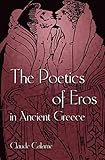The Poetics of Eros in Ancient Greece / Claude Calame.
Material type: TextPublisher: Princeton, NJ : Princeton University Press, [2013]Copyright date: ©1999Edition: Core TextbookDescription: 1 online resource (200 p.) : 1 line illus. 9 halftones 1 tableContent type:
TextPublisher: Princeton, NJ : Princeton University Press, [2013]Copyright date: ©1999Edition: Core TextbookDescription: 1 online resource (200 p.) : 1 line illus. 9 halftones 1 tableContent type: - 9780691159430
- 9781400849154
- 881.01093538
- PA3111 .C35 2013
- online - DeGruyter
- Issued also in print.
| Item type | Current library | Call number | URL | Status | Notes | Barcode | |
|---|---|---|---|---|---|---|---|
 eBook
eBook
|
Biblioteca "Angelicum" Pont. Univ. S.Tommaso d'Aquino Nuvola online | online - DeGruyter (Browse shelf(Opens below)) | Online access | Not for loan (Accesso limitato) | Accesso per gli utenti autorizzati / Access for authorized users | (dgr)9781400849154 |
Frontmatter -- CONTENTS -- ILLUSTRATIONS -- FOREWORD -- PREFACE -- NOTE ON TRANSLATIONS -- LIST OF ABBREVIATIONS -- Tragic Prelude -- PART ONE. THE TOPICS OF EROS -- Chapter I: THE EROS OF THE MELIC POETS -- Chapter II: THE EROS OF EPIC POETRY -- PART TWO. THE SYMBOLIC PRACTICES OF EROS -- Chapter III: THE PRAGMATIC EFFECTS OF LOVE POETRY -- Chapter IV: THE PRAGMATICS OF EROTIC ICONOGRAPHY -- PART THREE. EROS IN SOCIAL INSTITUTIONS -- Chapter V: EROS IN THE MASCULINE: THE POLIS -- Chapter VI: EROS IN THE FEMININE: THE OIKOS -- Chapter VII: DIONYSIAC CHALLENGES TO LOVE -- PART FOUR. THE SPACES OF EROS -- Chapter VIII: THE MEADOWS AND GARDENS OF LEGEND -- Chapter IX: THE MEADOWS AND GARDENS OF THE POETS -- PART FIVE. THE METAPHYSICS OF EROS -- Chapter X: EROS AS DEMIURGE AND PHILOSOPHER -- Chapter XI: MYSTIC EROS -- Elegiac Coda -- BIBLIOGRAPHY -- NAME INDEX -- SUBJECT INDEX
restricted access online access with authorization star
http://purl.org/coar/access_right/c_16ec
The Poetics of Eros in Ancient Greece offers the first comprehensive inquiry into the deity of sexual love, a power that permeated daily Greek life. Avoiding Foucault's philosophical paradigm of dominance/submission, Claude Calame uses an anthropological and linguistic approach to re-create indigenous categories of erotic love. He maintains that Eros, the joyful companion of Aphrodite, was a divine figure around which poets constructed a physiology of desire that functioned in specific ways within a network of social relations. Calame begins by showing how poetry and iconography gave a rich variety of expression to the concept of Eros, then delivers a history of the deity's roles within social and political institutions, and concludes with a discussion of an Eros-centered metaphysics. Calame's treatment of archaic and classical Greek institutions reveals Eros at work in initiation rites and celebrations, educational practices, the Dionysiac theater of tragedy and comedy, and in real and imagined spatial settings. For men, Eros functioned particularly in the symposium and the gymnasium, places where men and boys interacted and where future citizens were educated. The household was the setting where girls, brides, and adult wives learned their erotic roles--as such it provides the context for understanding female rites of passage and the problematics of sexuality in conjugal relations. Through analyses of both Greek language and practices, Calame offers a fresh, subtle reading of relations between individuals as well as a quick-paced and fascinating overview of Eros in Greek society at large.
Issued also in print.
Mode of access: Internet via World Wide Web.
In English.
Description based on online resource; title from PDF title page (publisher's Web site, viewed 30. Aug 2021)


